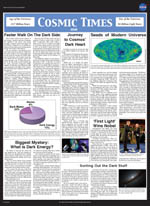2006 Cosmic Times Articles

This poster is the sixth issue of Cosmic Times, with the publication date chosen to encompass the discovery and subsequent confirmations of the presence of dark energy in our universe. This edition discusses some of the most recent pieces of evidence for dark energy and NASA's future plans for pinning down its elusive nature. In so doing, we return to the cosmic microwave background (CMB).
Jump to:
Content Overview :: Downloads :: Articles :: Lessons :: Style Notes
Content Overview
This sixth issue of Cosmic Times brings the discovery and evidence for dary energy as a major component of our universe. Dark energy was first glimpsed in 1997 with observations of distant supernovae. In the intervening time, astronomers have confirmed its presence and measured its abundance in the Universe. In addition, the scientists responsible for the COBE mission, so important in the 1993 Cosmic Times, were awarded the Nobel prize for physics in 2006. Finally, NASA sets its sights on the future of dark energy, planning a mission to measure a large number of supernovae to better map the expansion of the Universe over time.
Downloads
- 2006 Poster (printable at 8.5" x 11" or at its full size of 24" x 33"): pdf
- 2006 Newsletters:
- 2006 Questions for Understanding: doc, pdf
- 2006 Glossary: doc, pdf
- Full Cosmic Times Glossary: doc, pdf
- Educator's guide for all Cosmic Times editions: doc, pdf
Articles
- Age of the Universe: 2 Billion Years; Size of the Universe: 200 Million Light Years
Learn more about the age and size → - Faster Walk on the Dark Side
- Summary: Recent observations have confirmed the 1997 discovery that the universe is expanding at an increasing rate. These new observations also show the relative abundances of dark energy, dark matter, and ordinary matter.
- Thread: Expanding Universe
- Additional background and information →
- Seeds of Modern Universe
- Summary: Another satellite charged with studying the Cosmic Microwave Background has returned a detailed baby picture of the universe, with the seeds of moder structures finally coming through.
- Thread: Expanding Universe
- Additional background and information →
- Biggest Mystery: What is Dark Energy?
- Summary:The nature of dark energy is still a puzzle, with several theories in current contention, including the cosmological constant and quintessence.
- Thread: Expanding Universe
- Additional background and information →
- Sidebar: Sorting Out the Dark Stuff
- Summary: A brief description to clarify the difference between "dark energy" and "dark matter" – two very different unseen components of the universe.
- Additional background and information →
- 'First Light' Wins Nobel
- Summary: The scientists responsible for the first detailed spectrum and map of the cosmic microwave background are honored with the Nobel prize for physics.
- Additional background and information →
- Journey to Cosmos' Dark Heart
- Summary: NASA plans to study the nature of dark energy in more detail by collecting data for ever-more-distant supernovae. Three satellite missions are currently in contention.
- Additional background and information →
Lesson Plans
Download a .zip file containing all 2006 lessons with their associated handouts: doc, pdf
Note: that the Excel data file accompanying the "Measuring Dark Energy" lesson plan is included in the .doc file.
- Measuring Dark Energy
- Tools of the Trade
- Cosmic Times 2019
- Things Are Not What They Seem
- Century Timeline
- Overview: Students create a timeline of world events from 1905 through 2006, the years encompassed by the Cosmic Times posters, to get a sense of the history surrounding the discoveries over the past century.
- Grades: middle school and high school
- Topics: Multidisciplinary
- Download
Style Notes
The language in the 2006 newpaper mimicks the style of writing that currently appears in newspapers, which should be easier to read than earlier editions. However, the concepts may be harder to grasp, so, as with other editions, we have provided three versions of the text in newletter form: an Early Edition aimed at 7-8 graders, a Home Edition aimed at 9-10 Grades (with text from the online edition), and a Late Edition aimed at 11-12 Grades (with the text from the poster). These, along with a glossary and questions for understanding are available above.
The poster also shows a layout that mimicks modern newspapers; however, we have taken some creative license to make it more readable in a classroom setting.



